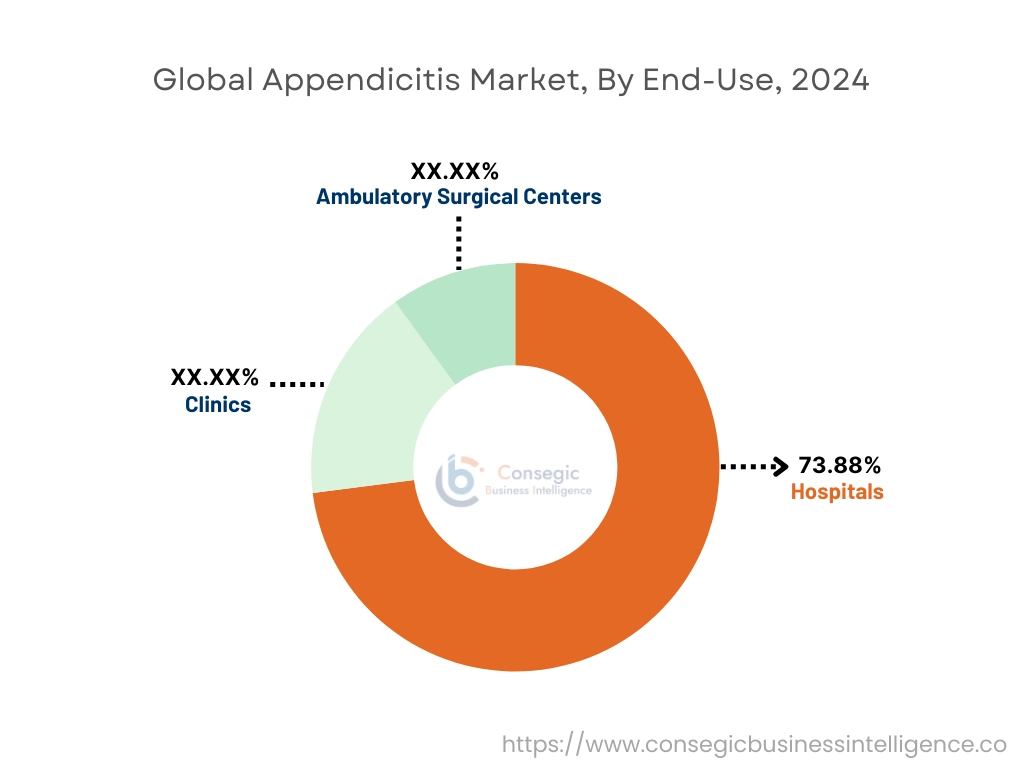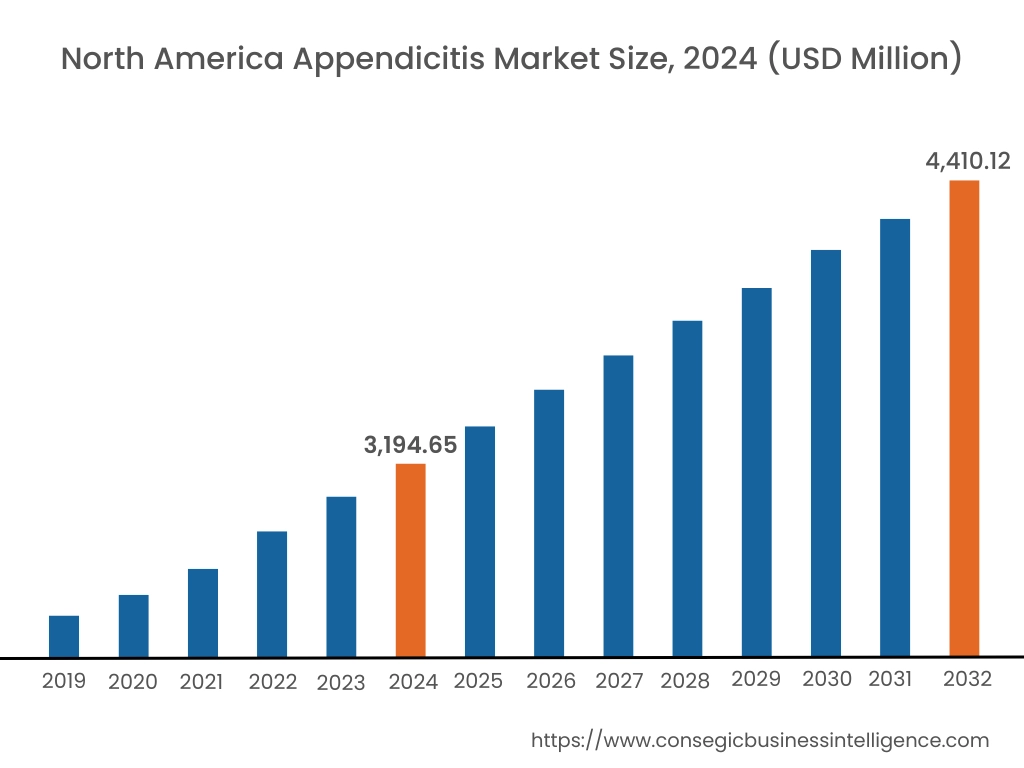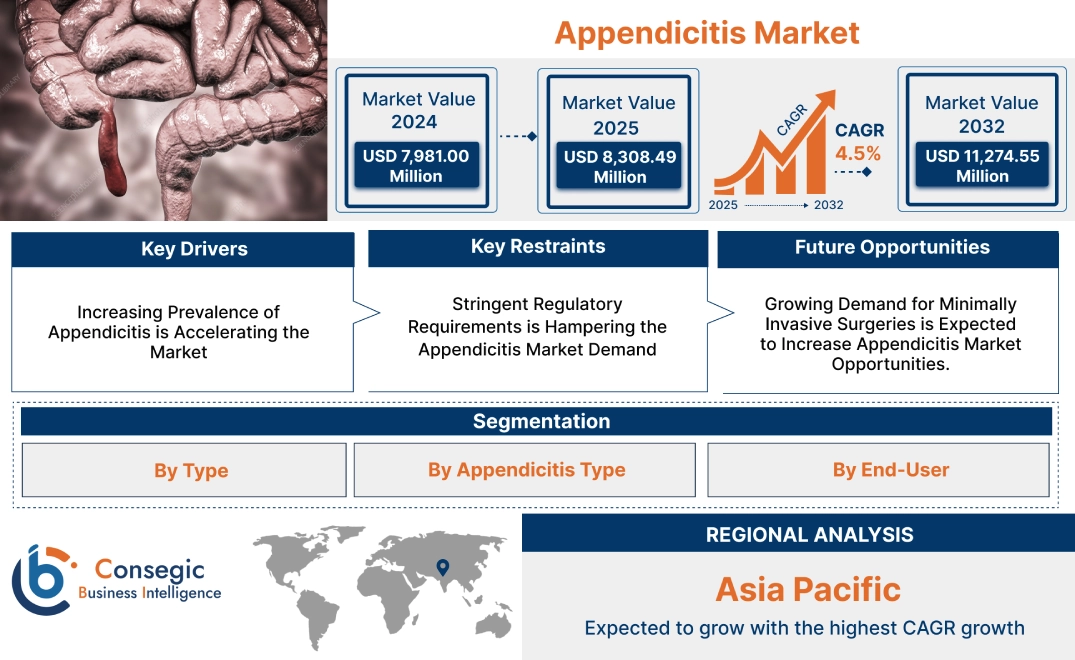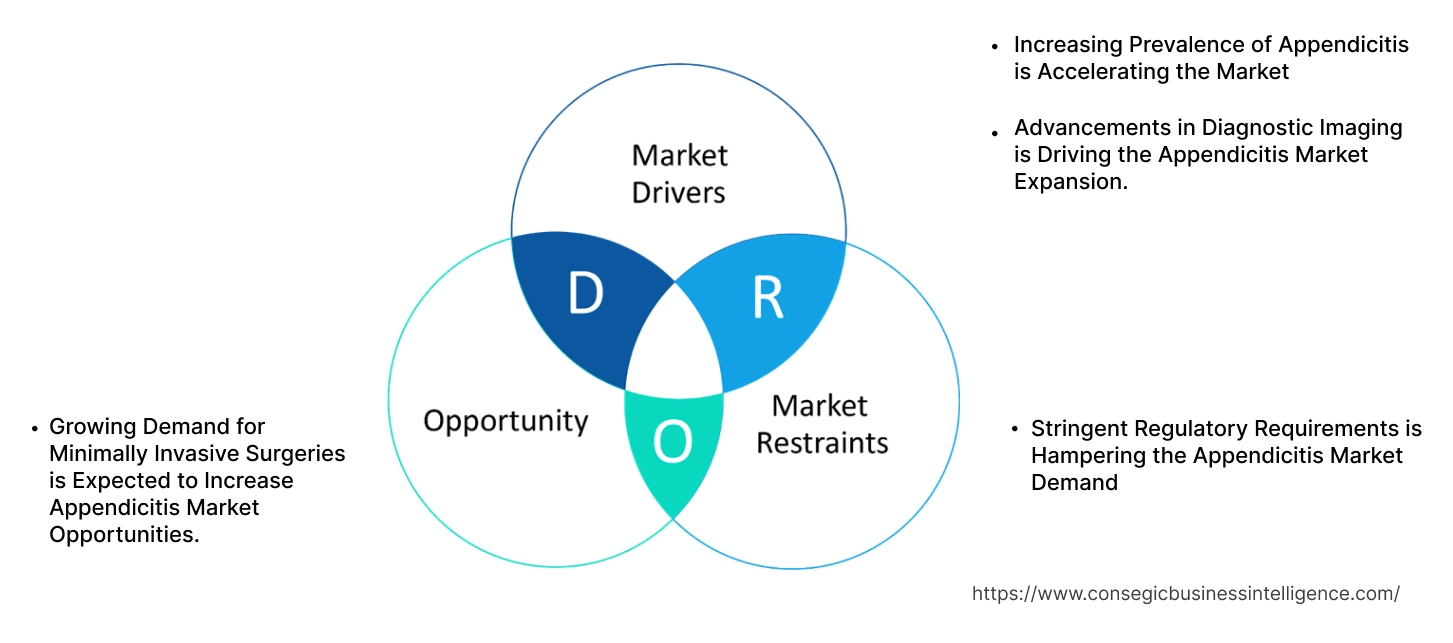- Summary
- Table Of Content
- Methodology
Appendicitis Market Size:
Appendicitis Market size is growing with a CAGR of 4.5% during the forecast period (2025-2032), and the market is projected to be valued at USD 11,274.55 Million by 2032 from USD 7,981.00 Million in 2024. Additionally, the market value for the 2025 attributes to USD 8,308.49 Million.
Appendicitis Market Scope & Overview:
The appendix is a small pouch attached to the large intestine. Appendicitis is a medical condition when this appendix becomes infected or inflamed. It causes severe abdominal pain. The other symptoms include nausea, vomiting, and fever. This inflammation bursts and leads to serious infections if not timely treated. This medical condition is divided into two types, acute and chronic. Acute happens suddenly and it needs quick treatment. The treatment is usually surgery. The chronicle is less common. It has long-lasting symptoms that come and go. Doctors use ultrasound, CT scans, and blood tests to check for this inflammation. The treatment includes medications such as antibiotics for mild cases. However, most people need appendectomy surgery. The surgical process removes the appendix. Hospitals, clinics, and ambulatory surgical centers are the main places where appendicitis is diagnosed and treated.
Key Drivers:
Increasing Prevalence of Appendicitis is Accelerating the Market
Appendicitis is a medical condition when the appendix becomes swollen and painful. Doctors use ultrasound or CT scans for its detection. The treatment includes surgery where appendix is removed. It helps patients recover fast. Antibiotics are used in mild cases. Unhealthy diets and lifestyle changes have led to increase in the cases of this medical condition.
For instance,
- According to Institute for Health Metrics and Evaluation, 17 million new cases were reported of appendicitis in year 2021. This has increased demand for diagnosis and treatments, thus driving market share.
Overall, the increasing prevalence of appendicitis is significantly boosting market growth.
Advancements in Diagnostic Imaging is Driving the Appendicitis Market Expansion.
New technologies are helping in detecting appendicitis early. Advanced 3D ultrasound provides more detailed images. Moreover, portable and handheld devices are helping doctors in detection of appendix inflammation cases in remote areas. Additionally, artificial intelligence (AI) and deep learning (DL) are also changing the landscape of the market.
For instance,
- According to a study published in MDPI, in 2024, artificial neural networks are increasing the specificity, which is helping with accurate acute form diagnosis that is missed by other methods. It is helping doctors in taking treatment decisions and preventing unnecessary surgeries, thus driving the market.
Thus, advancements in diagnostic imaging is accelerating the global appendicitis market expansion.
Key Restraints:
Stringent Regulatory Requirements is Hampering the Appendicitis Market Demand
The market faces hurdles due to strict regulatory approvals required for medical devices and medications. Regulatory bodies such as U.S. Food and Drug Administration (FDA) and European Medicines Agency (EMA) closely monitor diagnostic devices and new medicines. Before they get approved, companies must go through long clinical trials. This is important to prove they are safe and work well. Even after approval, companies must provide ongoing data about patient safety.
These regulations help protect patients, but they slow down innovation. It also increases treatment costs. Moreover, the regulatory process varies by country and region. This creates barriers for companies who aim for international commercialization. Hence, the stringent regulatory requirements are hampering the appendicitis market demand.
Future Opportunities :
Growing Demand for Minimally Invasive Surgeries is Expected to Increase Appendicitis Market Opportunities.
Minimally invasive surgery such as laparoscopic appendectomy uses tiny cameras and instruments to remove the appendix with small incisions. This leads to less pain, fewer scars, and a faster recovery compared to open surgery. Patients spend less time in the hospital and return to normal activities sooner. There is growing awareness of benefits MIS provides among patients which is leading to increased demand for it.
For instance,
- According to Far North Surgery, the global minimally invasive surgery market is expected to grow at CAGR of 7.5%. This presents prospects for manufacturers to create devices which align MIS technique, thus creating potential for global appendicitis market growth.
Overall, the growing need for minimally invasive surgeries is expected to increase appendicitis market opportunities.
Appendicitis Market Segmental Analysis :
By Type:
Based on type, the market is categorized into diagnosis and treatment.
Trends in Type:
- CT scans remain the primary diagnostic tool. It is due to their accuracy and ability to visualize the appendix.
- Laparoscopic appendectomy is the most common surgical approach. It is due to its minimally invasive nature which provides faster recovery and reduced scaring.
The treatment segment accounted for the largest market share in 2024 and is expected to grow at the fastest CAGR over the forecast period.
- The treatment segment dominated the appendicitis market trends. It is further categorized into medications and surgery.
- Medications such as antibiotics are sometime used for mild cases. Surgery provides quick effective solutions.
- Surgery is done in an open way or minimally invasive way. Surgery removes the suffering appendix past from the body.
- To improve surgical outcomes, manufacturers are launching advanced analytics to support surgical procedures.
- For instance, in 2024, Medtronic launched 14 new AI-drive algorithms to expand laparoscopic procedure capabilities. These improvements are helping in decision-making and improving patient outcomes.
- Overall, as per the market analysis, new product innovations are driving a segment in appendicitis market growth. Growing government initiatives will further support segment growth in upcoming years.
By Appendicitis Type:
Based on appendicitis type, the market is categorized into acute and chronic.
Trends in Appendicitis Type:
- Growing focus on more precise classification into acute subtypes such as catarrhal, phlegmonous, gangrenous, perforated to improve patient outcomes.
- Chronic type is increasingly recognized as a distinct entity. The awareness of its symptoms and diagnostic criteria is growing.
The acute segment accounted for the largest market share in 2024 and is expected to grow at the fastest CAGR over the forecast period.
- Acute segment dominated the appendicitis market trends. It is a sudden inflammation of the appendix, which is an organ attached to large intestine.
- It causes severe pain in the lower abdomen. Nausea, vomiting, and fever are other symptoms.
- Junk food, lack of physical exercise, smoking, and low-fiber diets have led to an increase in cases of acute type.
- For instance, according to a study published by the Springer Nature, in 2025, acute type has incidence of 150-250 new cases per 100,000 individuals annually.
- According to market analysis, increased cases of acute types are driving the segment. Moreover, increasing access to healthcare in remote areas will further support the segment for the forecast period.
By End-User:
Based on end-use, the market is categorized into hospitals, clinics, and ambulatory surgical centers.
Trends in the End-Use:
- Hospitals are focusing on streamlining emergency department protocols to expedite the diagnosis and treatment.
- Ambulatory surgical centers are increasingly being utilized for uncomplicated appendectomies. They offer a more cost-effective and convenient setting for eligible patients.
The hospitals segment accounted for the largest market share of 73.88% in 2024.
- The hospitals segment dominated the market trends. They serve as the primary facilities for this medical emergency.
- They have all the advanced equipment’s required for both diagnosis and treatment. They have highly skilled surgeons.
- Moreover, they are capable of handling all high-risk cases that too 24/7. Additionally, they have a high influx of patients due to insurance coverage and referral system.
- Improved access to healthcare has led to more people seeking treatment, including hospitalizations.
- For instance, according to an article published by The American College of Surgeons, in 2024, over 300,000 hospitalizations are carried out for surgical procedures annually in the United States.
- Overall, as per the market analysis, improved access to healthcare is driving segmental growth in the appendicitis industry.
The ambulatory segment is expected to grow at the fastest CAGR over the forecast period.
- The ambulatory surgical center is emerging in market trends. These centers offer specialized care in a faster manner.
- They are specially known for performing minimally invasive surgeries. It is less painful and provides faster recovery. It has fewer complications and reduces infection risks.
- Moreover, these ambulatory centers have less waiting times and specialize in same-day surgeries, which reduce patients overnight stay.
- Additionally, they are cheaper than hospitals. This makes it a good option for individuals with limited insurance or budget.
- Thus, the rising demand for minimally invasive surgeries will drive segmental growth.
- Also, the rise in healthcare costs and growing focus on patient centric treatment approaches further support the segment for the upcoming years.

Regional Analysis:
The regional segment includes North America, Europe, Asia Pacific, the Middle East and Africa, and Latin America.

In 2024, North America accounted for the highest appendicitis market share at 40.03% and was valued at USD 3,194.65 Million and is expected to reach USD 4,410.12 Million in 2032. In North America, the U.S. accounted for the appendicitis market share of 71.22% during the base year of 2024. People in the region are consuming low-fiber and high-fat foods, which is leading to appendix blockage and inflammation. This is increasing the increasing demand for diagnostic tests, emergency care, and surgeries. Moreover, medical companies are developing better laparoscopes for minimally invasive appendectomies. High-definition cameras, 3D imaging, and robotic-assisted tools improve surgery precision, reducing pain and recovery time.
For instance,
- In 2024, LivsMed launched ArtiSential 5, the first 5mm wristed articulating laparoscopic instrument series, expanding its ArtiSential line with enhanced flexibility. This has increased surgery accessibility, driving the market.
Overall, rising incidences of appendix inflammation and product innovations are driving the market in the region.

In Asia Pacific, the appendicitis market is experiencing the fastest growth with a CAGR of 5.1% over the forecast period. APAC is seeing major improvements in diagnostic imaging. Better ultrasound, CT scans, and MRI machines are helping doctors detect appendicitis faster and more accurately. These advancements help speed up treatment decisions, leading to better patient outcomes and driving market growth. Moreover, many countries in APAC, such as China, India, and Southeast Asian nations, are building more hospitals and healthcare centers. Governments are investing in better medical facilities. By this, more people get timely diagnosis and surgery, increasing the market in region.
Europe's appendicitis market analysis states that several trends are responsible for the progress of the market in the region. In Europe, more patients and doctors prefer minimally invasive surgeries (MIS) such as laparoscopic appendectomy. MIS uses small cuts, special cameras, and robotic tools. This leads to less pain, quicker recovery, and fewer scars. Advanced robot-assisted surgery is also becoming popular. It is improving precision and patient safety. Moreover, many European countries have government-funded healthcare systems that cover diagnosis and treatment costs. Patients receive financial support for hospital stays, surgeries, and post-surgical care, making treatment affordable. Private insurance also helps cover laparoscopic procedures and advanced treatments.
The Middle East and Africa (MEA) appendicitis market analysis states that the region is also witnessing several trends for a notable surge. More ambulatory surgical centers (ASCs) are opening to provide faster and cost-effective treatment. ASCs offer same-day surgeries such as laparoscopic appendectomy. This allows patients to recover at home quickly. These centers reduce hospital overcrowding and provide affordable, high-quality care. Moreover, MEA governments are investing more in advanced medical equipment and surgical training. Subsidies are helping to lower treatment costs, making surgery more accessible.
Latin America's appendicitis market size is also emerging. Healthcare industry spending is increasing in the region. It is leading to better healthcare facilities and skilled medical staff. Governments and private sectors are investing more in emergency care, making diagnosis and treatment faster and safer. More funding also helps hospitals adopt minimally invasive surgeries (MIS), such as laparoscopic appendectomy. Moreover, many healthcare organizations are working together to expand medical services to rural areas. Mobile clinics and telemedicine are helping to diagnose and treat appendicitis in remote regions.
Top Key Players & Market Share Insights:
The Appendicitis market is highly competitive with major players providing products to the national and international markets. Key players are adopting several strategies in research and development (R&D) and product innovation to hold a strong position in the global Appendicitis market. Key players in The Appendicitis industry include-
- Medtronic Plc (Ireland)
- LivsMed, Inc. (U.S.)
- Lianyungang Dongtai Food Ingredients Co., Ltd (China)
- Toyo Denka Kogyo Co., Ltd. (Japan)
- Becton Dickison (U.S.)
- ConMed Corp (U.S.)
- Johnson & Johnson (U.S.)
- Olympus Corporation (Japan)
- Stryker Corporation (U.S.)
- Karl Storz (Germany)
- Pfizer (U.S.)
- Novartis AG (Switzerland)
Recent Industry Developments :
- In October 2024, LivsMed launched ArtiSential 5, which is a new line of 5mm diameter, wristed articulating laparoscopic surgical instruments. It offers enhanced flexibility and ease of use compared to their standard ArtiSential line. It also allows for greater precision and maneuverability during minimally invasive procedures.
- In April 2024, Medtronic launched 14 new AI-powered algorithms on their Touch Surgery Performance Insights platform. It is designed to enhance post-operative analysis of both laparoscopic and robotic-assisted surgeries by providing detailed insights into surgical workflow, instrument usage, and anatomy detection.
Appendicitis Market Report Insights :
| Report Attributes | Report Details |
| Study Timeline | 2019-2032 |
| Market Size in 2032 | USD 11,274.55 Million |
| CAGR (2025-2032) | 4.5% |
| By Type |
|
| By Appendicitis Type |
|
| By End-Use |
|
| By Region |
|
| Key Players |
|
| North America | U.S. Canada Mexico |
| Europe | U.K. Germany France Spain Italy Russia Benelux Rest of Europe |
| APAC | China South Korea Japan India Australia ASEAN Rest of Asia-Pacific |
| Middle East and Africa | GCC Turkey South Africa Rest of MEA |
| LATAM | Brazil Argentina Chile Rest of LATAM |
| Report Coverage |
|
Key Questions Answered in the Report
How big is the Appendicitis market? +
In 2024, the Appendicitis market is USD 7,981.00 Million.
Which is the fastest-growing region in the Appendicitis market? +
Asia Pacific is the fastest-growing region in the Appendicitis market.
What specific segmentation details are covered in the Appendicitis market? +
Type, Appendicitis Type, and End-Use segmentation details are covered in the Appendicitis market
Who are the major players in the Appendicitis market? +
Medtronic Plc (Ireland), LivsMed, Inc. (U.S.), Johnson & Johnson (U.S.), Olympus Corporation (Japan), and Stryker Corporation (U.S.) are some major players in the market.


